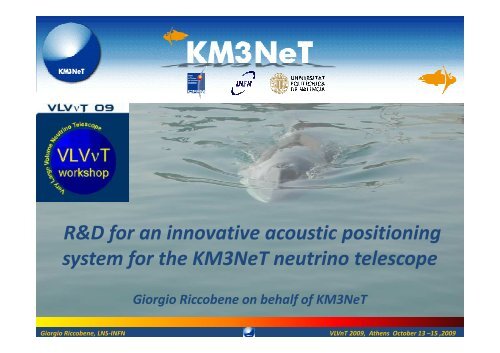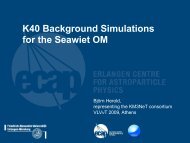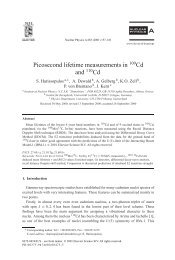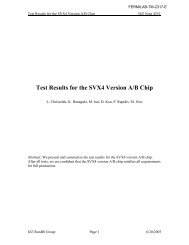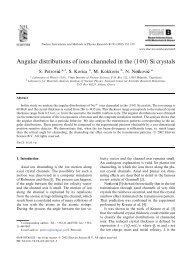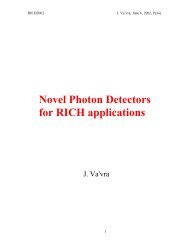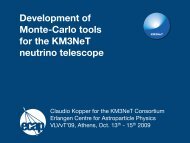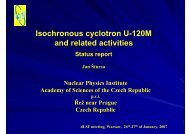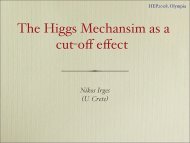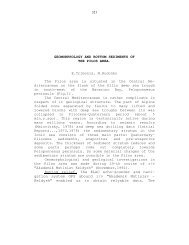R&D for an innovative acoustic positioning system for the KM3NeT ...
R&D for an innovative acoustic positioning system for the KM3NeT ...
R&D for an innovative acoustic positioning system for the KM3NeT ...
Create successful ePaper yourself
Turn your PDF publications into a flip-book with our unique Google optimized e-Paper software.
R&D <strong>for</strong> <strong>an</strong> <strong>innovative</strong> <strong>acoustic</strong> <strong>positioning</strong><br />
<strong>system</strong> <strong>for</strong> <strong>the</strong> <strong>KM3NeT</strong> neutrino telescope<br />
Giorgio Riccobene on behalf of <strong>KM3NeT</strong><br />
Giorgio Riccobene, LNS-INFN VLVnT 2009, A<strong>the</strong>ns October 13 –15 ,2009
The deep sea <strong>acoustic</strong> <strong>positioning</strong> <strong>system</strong><br />
The <strong>acoustic</strong> <strong>positioning</strong> is a m<strong>an</strong>datory sub<strong>system</strong> <strong>for</strong> <strong>the</strong> detector<br />
Requirements:<br />
• relative <strong>positioning</strong> accuracy:
Key elements of <strong>the</strong> deep sea <strong>acoustic</strong> <strong>positioning</strong> <strong>system</strong><br />
Key elements <strong>for</strong> <strong>the</strong> Acoustic Positioning System (APS)<br />
- Auto-calibrating Long Baseline of <strong>acoustic</strong> tr<strong>an</strong>sceivers <strong>an</strong>chored in known<br />
<strong>an</strong>d fixed positions.<br />
- Array of <strong>acoustic</strong> sensors (hydrophones) moving with <strong>the</strong> Detection Unit<br />
mech<strong>an</strong>ical structure<br />
- Data acquisition <strong>an</strong>d tr<strong>an</strong>smission <strong>system</strong><br />
- Data <strong>an</strong>alysis <strong>system</strong><br />
Detection<br />
Unit<br />
Measurement Technique:<br />
1) TDoA (Time Difference of Arrival)<br />
T Emit (Beacon) – T Receive (Hydro)<br />
Hydrophone<br />
2) Geometrical Tri<strong>an</strong>gulation<br />
LBL<br />
tr<strong>an</strong>sceivers<br />
Giorgio Riccobene, LNS-INFN VLVnT 2009, A<strong>the</strong>ns October 13 –15 ,2009
Requirements <strong>for</strong> TDOA measurements<br />
- Common (<strong>an</strong>d absolute) timing <strong>for</strong> beacons <strong>an</strong>d hydrophones:<br />
phased <strong>an</strong>d shyncronised apparatus with
The NEMO Phase 1 experience<br />
In NEMO Phase 1 <strong>an</strong> <strong>acoustic</strong> <strong>positioning</strong> <strong>system</strong> based on commercial technology was<br />
used. We used <strong>an</strong> “<strong>acoustic</strong> poisitionig board” with DSP onboard connected to <strong>the</strong> FCM:<br />
<strong>acoustic</strong> signal <strong>an</strong>alysis underwater beacon signal detection time sent to shore to<br />
recover hydrophone position.<br />
GPS Time packet (1 Hz)<br />
15 m<br />
300 m<br />
Acoustic<br />
<strong>positioning</strong> board<br />
200 kHz digitization<br />
Detection time of<br />
Beacon Signal<br />
Independent<br />
Beacon<br />
Acoustic<br />
<strong>positioning</strong> PCs<br />
Giorgio Riccobene, LNS-INFN VLVnT 2009, A<strong>the</strong>ns October 13 –15 ,2009
The NEMO Phase 1 experience<br />
Calculation of dist<strong>an</strong>ce beetween <strong>the</strong> two hydrophones installed on a Floor<br />
Measured dist<strong>an</strong>ce in laboratory = 14.25 m<br />
Me<strong>an</strong> value from <strong>acoustic</strong> data = 14.24 m<br />
Giorgio Riccobene, LNS-INFN VLVnT 2009, A<strong>the</strong>ns October 13 –15 ,2009
The NEMO- OνDE experience: Oce<strong>an</strong> Noise Detection Experiment<br />
4 hydrophones (10 Hz-40 kHz b<strong>an</strong>dwidth) synchronized.<br />
Acoustic signal digitization (24bit@96 kHz) at 2000m depth.<br />
Data tr<strong>an</strong>smission on optical fibers over 28 km.<br />
On-line monitoring <strong>an</strong>d data recording on shore. Recording 5’ every hour.<br />
Data taking from J<strong>an</strong>. 2005 to Nov. 2006 (NEMO Phase 1 deployed).<br />
hydrophones<br />
electronics<br />
housing<br />
Average noise 2005-2006<br />
Sea State 2<br />
Sea State 0<br />
Giorgio Riccobene, LNS-INFN VLVnT 2009, A<strong>the</strong>ns October 13 –15 ,2009
The NEMO- OνDE experience: Oce<strong>an</strong> Noise Detection Experiment<br />
Sperm whale<br />
clicks<br />
Depth = 560 ± 5 m<br />
L = 3.41 ± 0.05 m<br />
Size = 9.72 - 10.50 m<br />
Young male or female<br />
OνDE sensitivity allowed cetace<strong>an</strong>s detection over >10 km r<strong>an</strong>ge.<br />
The results indicate presence of sperm whales more frequent th<strong>an</strong> previously<br />
observed.<br />
1 <strong>an</strong>imal<br />
Long term observation <strong>an</strong>d source<br />
2 <strong>an</strong>imals<br />
3 <strong>an</strong>imals<br />
tracking is used to determine marine<br />
>3 <strong>an</strong>imals<br />
mammals presence <strong>an</strong>d seasonal<br />
routes.<br />
INFN <strong>an</strong>d<br />
CIBRA<br />
Science, March 2, 2007<br />
Giorgio Riccobene, LNS-INFN VLVnT 2009, A<strong>the</strong>ns October 13 –15 ,2009
The ANTARES experience<br />
Acoustic Positioning System based on commercial technology (Genisea/ECA).<br />
LBL tr<strong>an</strong>sceivers on <strong>the</strong> BSSs <strong>an</strong>d receivers on <strong>the</strong> line.<br />
Line reconstruction: <strong>acoustic</strong> data + environmental sensors + compasses+ mech<strong>an</strong>ical model<br />
Tr<strong>an</strong>sceiver<br />
Receivers<br />
Floor 1<br />
Floor 8<br />
Floor 14<br />
Floor 20<br />
Floor 25<br />
BSS<br />
ANTARES Line<br />
Tr<strong>an</strong>sceivers<br />
Giorgio Riccobene, LNS-INFN VLVnT 2009, A<strong>the</strong>ns October 13 –15 ,2009
The ANTARES experience<br />
Absolute positions of LBL tr<strong>an</strong>ceivers:<br />
• Determined from surface (ship GPS)<br />
• Accuracy improved via LBL tri<strong>an</strong>gulation<br />
(tens cm)<br />
Detector <strong>an</strong>gular uncertainty<br />
σ (horizontal) = 0.13°<br />
σ (vertical) = 0.06°<br />
Giorgio Riccobene, LNS-INFN VLVnT 2009, A<strong>the</strong>ns October 13 –15 ,2009
R&D <strong>for</strong> <strong>an</strong> integrated Acosutic Positioning System<br />
Major innovations compared to <strong>the</strong> ANTARES <strong>an</strong>d NEMO Phase 1 experience<br />
• Fully time phased <strong>an</strong>d synchronised array of tr<strong>an</strong>smitters <strong>an</strong>d receivers<br />
• “All data to shore” philosophy<br />
Hydrophone data is rate fully sustainable<br />
Better/faster data <strong>an</strong>alysis tools on shore<br />
Large room <strong>for</strong> associated science et al.<br />
• Use of audio professional electronics components / data tr<strong>an</strong>smission protocols<br />
Reduce costs<br />
Improve reliability<br />
Integrate APS in <strong>the</strong> detector DAQ <strong>an</strong>d data tr<strong>an</strong>smission electronics<br />
Improve data exch<strong>an</strong>ge with associated science<br />
• Auto-calibrating <strong>an</strong>d multi-frequency LBL integrated with <strong>the</strong> DAQ chain<br />
Giorgio Riccobene, LNS-INFN VLVnT 2009, A<strong>the</strong>ns October 13 –15 ,2009
Proposed Acoustic Positioning System <strong>for</strong> <strong>the</strong> <strong>KM3NeT</strong><br />
Acoustic Positioning <strong>system</strong> :<br />
Minimal autocalibrating LBL (autonomous or cabled)<br />
Definitive autocalibrating LBL (connected to KM3 shore clock)<br />
tr<strong>an</strong>sceivers on junction boxes<br />
hydrophones on <strong>the</strong> tower floors<br />
PJB with LBL tr<strong>an</strong>sceiver<br />
Autonomous LBL<br />
SJB with LBL tr<strong>an</strong>sceiver<br />
Detection Unit<br />
MEOC<br />
Cable PJB-SJB<br />
Cable SJB-Tower<br />
Giorgio Riccobene, LNS-INFN VLVnT 2009, A<strong>the</strong>ns October 13 –15 ,2009
The hydrophone data acquition chain<br />
“All data to shore” philosophy payload: 2 Hydros = 12Mb/s, fully sustainable<br />
Hydros +<br />
preamps<br />
Acoustic Data Server<br />
ADS<br />
ADC<br />
Storey Control Module<br />
Adds GPS Time<br />
Sends Acou-data to shore<br />
TCP/IP<br />
Associated science<br />
OMs<br />
optical<br />
fiber link<br />
On-Shore<br />
Storey Conrtol Module<br />
Data Parsing<br />
Acoustic<br />
Positioning<br />
Storey scheme scheme<br />
Hydrophone frequency r<strong>an</strong>ge:<br />
Hydrophone (+ preamp) sensitivity<br />
ADC dynamic r<strong>an</strong>ge<br />
ADC sampling frequency<br />
1 kHz < f < 70 kHz<br />
∼ -170 dB re V/µPa<br />
∼ 120 dB (24 bits / 18÷20 bits effective)<br />
192 kHz (96 kHz optional)<br />
GPS time added offshore by <strong>the</strong> Storey Control Module<br />
Acoustic data tr<strong>an</strong>smission rate 32 bits @ 192 kHz 6.2 Mb/s (1 hydro)<br />
Giorgio Riccobene, LNS-INFN VLVnT 2009, A<strong>the</strong>ns October 13 –15 ,2009
The hydrophone data acquition chain<br />
“All data to shore” philosophy payload: 2 Hydros = 12Mb/s, fully sustainable<br />
Hydros +<br />
preamps<br />
Acoustic Data Server<br />
ADS<br />
ADC<br />
Storey Control Module<br />
Adds GPS Time<br />
Sends Acou-data to shore<br />
TCP/IP<br />
Associated science<br />
OMs<br />
optical<br />
fiber link<br />
On-Shore<br />
Storey Control Module<br />
Data Parsing<br />
Acoustic<br />
Positioning<br />
Storey scheme scheme<br />
Full data <strong>an</strong>alysis on shore with dedicated hardware <strong>an</strong>d/or software<br />
Data acquisition onshore:<br />
• The Storey Control Module onshore parses <strong>the</strong> Acoustic data from <strong>the</strong> data Stream<br />
• Acoustic Data are reconstructed <strong>an</strong>d distributed to clients by <strong>the</strong> ADS using<br />
professional Audio Borads (<strong>for</strong> tests) or custom FPGA-based boards.<br />
Giorgio Riccobene, LNS-INFN VLVnT 2009, A<strong>the</strong>ns October 13 –15 ,2009
R&D: Hydrophones <strong>an</strong>d Preamps<br />
Commercial hydrophones are typically factory calibrated:<br />
piston test at 250 Hz, water pool test above 5 kHz (due to reflections)<br />
directionality pattern<br />
But <strong>for</strong> m<strong>an</strong>y hydrophones sensitivity ch<strong>an</strong>ges as a function of pressure (∼ -3 dB/1000 m)<br />
INFN <strong>an</strong>d <strong>an</strong> itali<strong>an</strong> comp<strong>an</strong>y (SMID) have developed low cost hydrophones <strong>for</strong> 4000 m<br />
depth, with no ch<strong>an</strong>ge of sensitivity as a function of depth.<br />
NATO has developed <strong>for</strong>/with NEMO a st<strong>an</strong>dard procedure <strong>for</strong> calibration under pressure<br />
Hydrophone<br />
Preamplifier<br />
NATO/NURC (La Spezia) Calibration t<strong>an</strong>k dimensions: 4.6m long, 3.6m wide, 2.7m deep<br />
Instruments:<br />
PC with National Instrument PXI 6115 DAQ card & GPIB<br />
HP 33120a signal generator interfaced through GPIB bus<br />
St<strong>an</strong><strong>for</strong>d Research Systems DG 535 delay generator<br />
St<strong>an</strong><strong>for</strong>d Research Systems SRS 560 pre-amplifier<br />
Instruments Inc L2 power amplifier<br />
A new hydrophone with digital read-out interface has been recently developed by SMID<br />
Giorgio Riccobene, LNS-INFN VLVnT 2009, A<strong>the</strong>ns October 13 –15 ,2009
R&D: Hydrophones <strong>an</strong>d Preamps<br />
Calibration of 40 hydrophones using <strong>the</strong> NATO water t<strong>an</strong>k (1 bar)<br />
Hydrophone + preamp (+ 38 dB gain)<br />
Radiation lobe<br />
30 kHz<br />
50 kHz<br />
Giorgio Riccobene, LNS-INFN VLVnT 2009, A<strong>the</strong>ns October 13 –15 ,2009
R&D: Hydrophones <strong>an</strong>d Preamps<br />
Pressure calibration of 40 Hydrophones using <strong>the</strong> NATO pressure t<strong>an</strong>k<br />
Set-up <strong>for</strong> high pressure tests:<br />
measurement of relative sensitivity losses<br />
Relative Hydrophone sensitivity<br />
variation with hydrostatic<br />
pressure at 20 kHz<br />
• Hydrophone placed in pressure vessel filled<br />
with oil <strong>an</strong>d immersed in a calibration t<strong>an</strong>k<br />
• A projector (ITC1042) is placed at<br />
approximately 1 m from <strong>the</strong> pressure vessel<br />
300 Bar 400 Bar<br />
• Pressure is increased to 400 bar <strong>an</strong>d<br />
allowed to settle <strong>for</strong> 30 minutes.<br />
• Hydrophone signal is acquired at<br />
400, 300 <strong>an</strong>d 50 bar.<br />
Measured variations ≤ ±1 dB<br />
Giorgio Riccobene, LNS-INFN VLVnT 2009, A<strong>the</strong>ns October 13 –15 ,2009
Tests with <strong>KM3NeT</strong> “backup solution” data tr<strong>an</strong>smission electronics<br />
The Acoustic Board design is based on commercial audio professional components:<br />
ADC Stereo 24 bit/192 kHz Max input 2 V RMS<br />
AES3 compli<strong>an</strong>t DIT (Data Interface Tr<strong>an</strong>smitter)<br />
power 160 mA @ 5.3VDC<br />
Devices are piloted by 24.576 MHz Clock from <strong>the</strong> FCM (<strong>for</strong> 192 kHz sampling rate)<br />
Power to<br />
preamps<br />
FCM off-shore<br />
adds GPS time to <strong>the</strong><br />
audio data stream<br />
11 cm<br />
Acoustic Board<br />
Digital audio<br />
data (out)<br />
clock, reset<br />
(in)<br />
FCM on-shore<br />
distributes <strong>the</strong> GPS<br />
time to <strong>the</strong>off-shore<br />
electronics<br />
Optical link shore-sea<br />
Analog signal inputs from preamps<br />
Digital Audio signal ouput<br />
Giorgio Riccobene, LNS-INFN VLVnT 2009, A<strong>the</strong>ns October 13 –15 ,2009
Time synchronization measurements<br />
Measurement of offshore electronics latency = 170 ± 1 µs <strong>for</strong> all boards<br />
Time of Trigger known<br />
(accuracy < ns )<br />
FCM off-shore<br />
Inserts time in<br />
<strong>acoustic</strong> data<br />
Optical link<br />
FCM<br />
on-shore<br />
Acoustic<br />
Data<br />
Server<br />
Trigger<br />
Signal<br />
Signal<br />
generator<br />
Acou<br />
Board<br />
Test set-up<br />
Received signal. Trigger Signal sent at T=0<br />
Sinusoidal<br />
wave<br />
preamp<br />
preamp<br />
∼100 ns delay with<br />
respect to trigger signal<br />
Giorgio Riccobene, LNS-INFN VLVnT 2009, A<strong>the</strong>ns October 13 –15 ,2009
Tests with autonomous beacon<br />
Response of <strong>the</strong> APS to <strong>an</strong> autonomous beacon (32 kHz, 180 dB re 1 µPa @ 1 m)<br />
Baecon Signal 5 ms<br />
In collaboration with ACSA, Mereuyle (F)<br />
32 kHz, -68 dB re<br />
V RMS / √Hz<br />
32000 pts FFT<br />
Giorgio Riccobene, LNS-INFN VLVnT 2009, A<strong>the</strong>ns October 13 –15 ,2009
Amplitude response <strong>an</strong>d electronics noise of <strong>the</strong> <strong>system</strong><br />
Assuming a Beacon pulse of 32 kHz<br />
180 dB re 1 µPa @ 1m<br />
Electronics Noise<br />
Giorgio Riccobene, LNS-INFN VLVnT 2009, A<strong>the</strong>ns October 13 –15 ,2009
Tests of <strong>acoustic</strong> tr<strong>an</strong>sceivers <strong>for</strong> <strong>the</strong> LBL<br />
Commercially available Free Flooded Rings (FFR) – SENSOR X-30<br />
tested by CCPM - IN2P3 <strong>an</strong>d UPV - G<strong>an</strong>dia @ Ifremer Brest<br />
- 440 Bar pressure tests<br />
- Multi frequency (25 to 40 kHz usable)<br />
tested at LNS-INFN with <strong>the</strong> whole DAQ chain<br />
SMID<br />
Hydrophone<br />
SENSOR X-30<br />
FFR<br />
Giorgio Riccobene, LNS-INFN VLVnT 2009, A<strong>the</strong>ns October 13 –15 ,2009
LBL tr<strong>an</strong>sceivers electronics (under design)<br />
Time of trigger known<br />
(accuracy < ns )<br />
FMC off-shore<br />
Optical link<br />
FMC<br />
on-shore<br />
Acoustic<br />
Data<br />
Server<br />
Trigger<br />
Signal<br />
Signal<br />
Generator<br />
Board<br />
Acou<br />
Board<br />
Digitized<br />
Data<br />
FCM on-shore<br />
Tr<strong>an</strong>smits GPS time<br />
Sends user trigger<br />
Sends user comm<strong>an</strong>ds <strong>an</strong>d settings<br />
Signal to<br />
tr<strong>an</strong>smitters<br />
preamp<br />
preamp<br />
FCM off-shore<br />
Inserts time in <strong>acoustic</strong>s data<br />
Interfaces comm<strong>an</strong>ds <strong>an</strong>d trigger to SGB<br />
FFR<br />
Signal Generator Board<br />
Pulse amplitude set<br />
Pulse frequency set<br />
Pulse repetition rate set<br />
Giorgio Riccobene, LNS-INFN VLVnT 2009, A<strong>the</strong>ns October 13 –15 ,2009
Adv<strong>an</strong>tages of <strong>the</strong> proposed design:<br />
Summary <strong>an</strong>d Outlook<br />
- Large cost reduction compared to commercial equivalent <strong>system</strong>s<br />
- Improved measurement accuracy<br />
- Compatibility with <strong>KM3NeT</strong> electronics <strong>an</strong>d data acquisition <strong>system</strong><br />
- Improved <strong>system</strong> reliability<br />
- Improved data h<strong>an</strong>dling / porting<br />
Definition of <strong>the</strong> <strong>acoustic</strong> <strong>positioning</strong> <strong>system</strong> architecture:<br />
Evaluate <strong>the</strong> minimum number of required hydrophones per Detection Unit<br />
“NEMO Phase 1 –like” set-up<br />
2 hydros per DU storey<br />
“ANTARES –like” set up :<br />
Mech<strong>an</strong>ical DU simulation<br />
Compasses / Slow control data<br />
1 hydro per DU storey<br />
2 hydros every 2 or 4 DU stories<br />
...<br />
Giorgio Riccobene, LNS-INFN VLVnT 2009, A<strong>the</strong>ns October 13 –15 ,2009
Fur<strong>the</strong>r perspectives<br />
Search <strong>for</strong> biological<br />
sounds<br />
Preliminary studies on <strong>acoustic</strong> neutrino detection<br />
Hydrophone b<strong>an</strong>d matches<br />
<strong>the</strong> b<strong>an</strong>d required <strong>for</strong> <strong>acoustic</strong><br />
neutrino detection.<br />
All data c<strong>an</strong> be <strong>an</strong>alysed in<br />
parallel by o<strong>the</strong>r end-users.<br />
neutrino<br />
weak interaction<br />
hadronic shower<br />
ν e<br />
e.m.shower<br />
Giorgio Riccobene, LNS-INFN VLVnT 2009, A<strong>the</strong>ns October 13 –15 ,2009
Fur<strong>the</strong>r perspectives<br />
ANTARES (Marseilles, Erl<strong>an</strong>gen)<br />
ACORNE<br />
1100 hydros in 1 km 3<br />
Acoustics<br />
.. with cuts<br />
- No cuts<br />
1 year, threshold 35 mPa, 95% CL<br />
(r<strong>an</strong>dom geometry)<br />
1500 km 3 , 200 hydros per km 3<br />
5 years<br />
threshold 5 mPa<br />
km 3 regular geometries<br />
5 years, 15 mPa, 95% CL<br />
10 years, threshold 5 mPa, 90% CL<br />
(r<strong>an</strong>dom geometry)<br />
A “complementary” km 3 -scale detector ?<br />
Giorgio Riccobene, LNS-INFN VLVnT 2009, A<strong>the</strong>ns October 13 –15 ,2009


